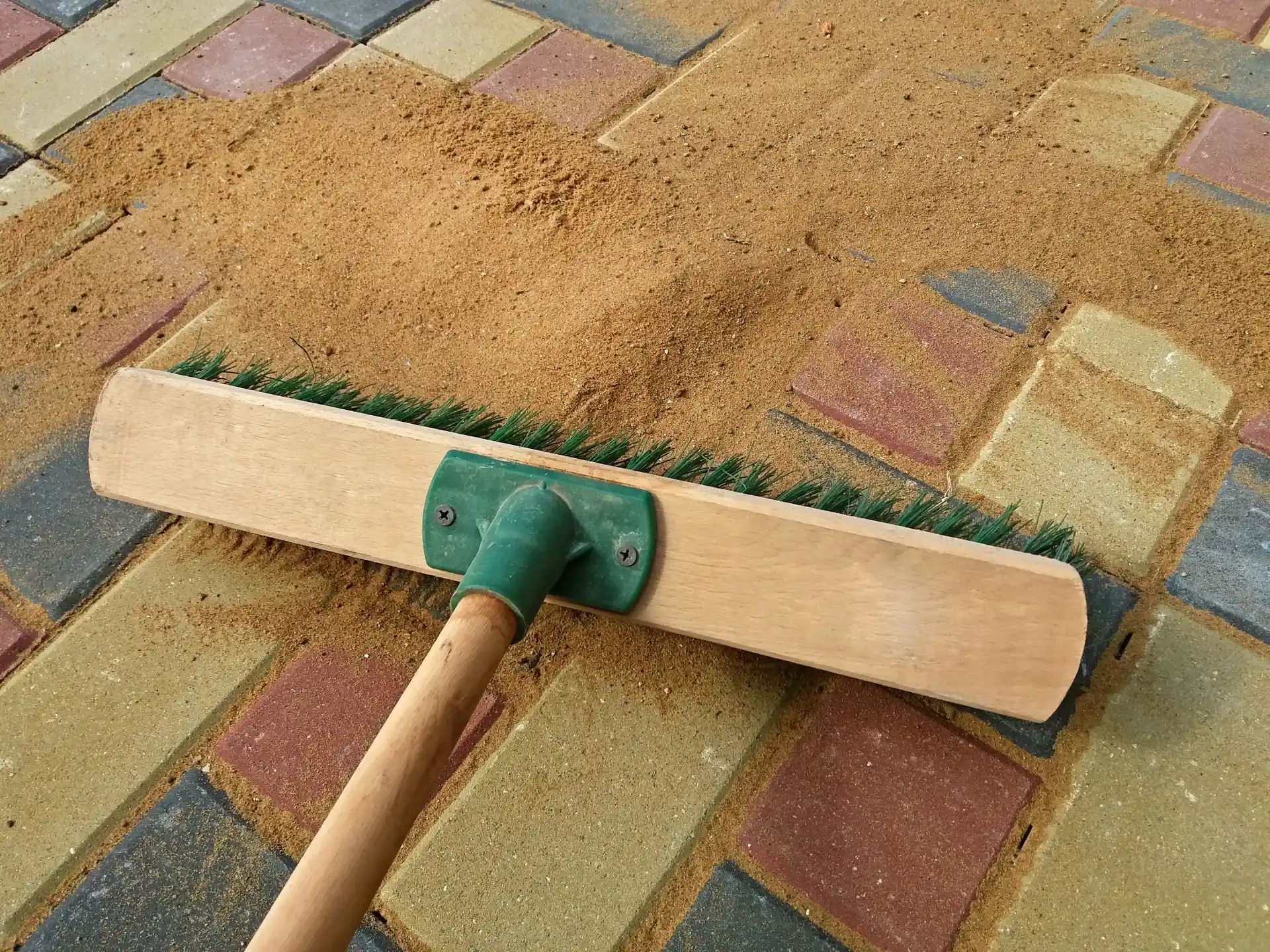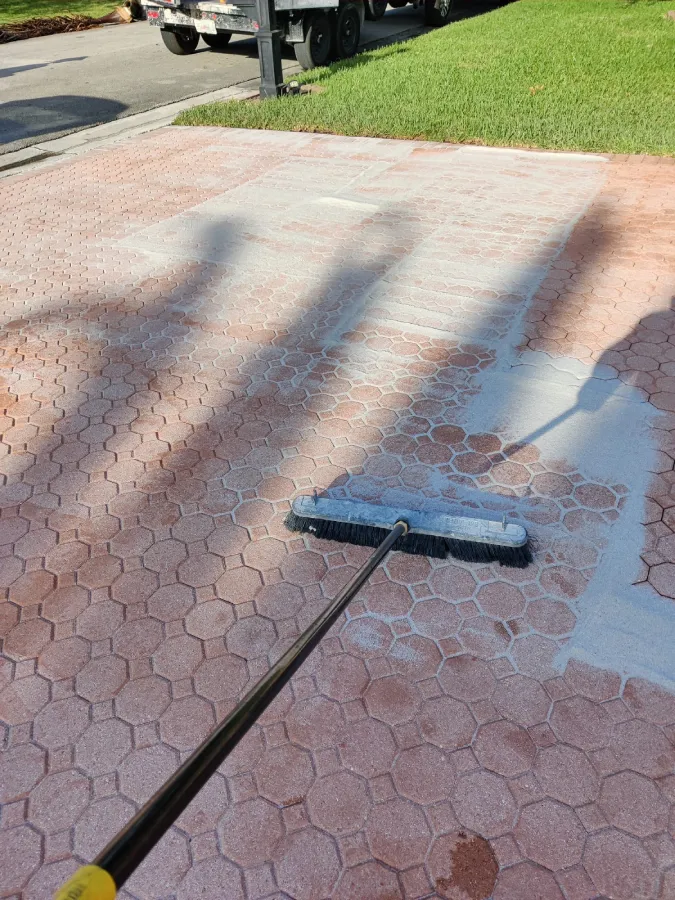
When you’re planning a hardscape project along the vibrant and ever-changing weather of Florida’s coast, selecting the right type of paver sand is crucial for the longevity and beauty of your patio or walkway. Paver sand, a fundamental component in the installation and maintenance of pavers, acts as a stabilizing base and joint filler. But not all sand is created equal. Understanding the differences and choosing the right type can be the difference between a hardscape that withstands the test of time and one that falters under harsh coastal conditions.
Polymeric sand is a blend specifically designed to endure the challenges posed by the weather on the coast of Florida. This unique blend for paver joints, when combined with proper preparation like the application of weed killer and insect repellent, offers enhanced protection against weed growth, rain washout, and insect penetration compared to traditional sand types. It’s an investment into the durability and maintenance ease of your hardscaping projects.
Whether you’re repairing existing pavers or embarking on a new installation, incorporating the right sand is a step you cannot afford to overlook. As experts in paver sealing and restoration, we emphasize the importance of choosing quality materials. The foundation of a lasting hardscape is in the quality of materials used, underscoring the significance of selecting superior pavers and sand for any coastal Florida project.
At the heart of every successful paver project lies the unsung hero – paver sand. This specialized sand plays a pivotal role in securing pavers in place, ensuring they remain stable and evenly spaced. But what makes paver sand so essential? Its ability to lock pavers together while still allowing for drainage and flexibility is key, especially in areas like Florida where the weather can go from sunny to stormy in an instant.
Polymeric sand, a blend of sand and special additives sand tech, is engineered to fill the joints between concrete pavers and brick pavers, creating a strong, durable bond that stands up to the elements. It’s not just about filling spaces; it’s about creating a barrier that protects against weed growth and insect infestation, thanks to the incorporation of weed killer and specific design to prevent rain washout. This makes it a superior choice for maintaining the pristine look and stability of your hardscape projects along the challenging coastal environment.
Imagine building a castle on the beach. Without the right foundation, the first wave washes it away. Similarly, paver projects without the right sand foundation can shift and sink, ruining your hard work. Paver sand is that foundation, ensuring paving stones stay in place, rain or shine, especially in the fluctuating weather conditions of Florida’s coast.
Choosing jointing sand specifically enhances this foundation. With its advanced formula, this paver joint sand not only fills gaps but also binds pavers together, forming a solid yet flexible joint. It’s like adding a shield against weed growth and the elements, crucial for the humid and rainy conditions often encountered. This level of protection and stability is what makes polymeric jointing sand a cornerstone in hardscaping success.
When pavers are installed, the space between them, known as the joint, plays a critical role in the overall stability of the paved area. The right paver joint sand fills these spaces snugly, creating friction and interlock that prevent shifting. Especially along Florida’s coast, where storms can be harsh, ensuring your pavers are well-anchored with the right sand can make all the difference in long-term stability and durability.
Choosing between polymeric sand and regular sand for your paver projects is like choosing between a waterproof watch and a standard watch for a swim. Polymeric sand, with its special bonding agents, is designed to withstand the challenging weather conditions of Florida’s coast, offering enhanced durability and resistance to washout. It’s tailored to keep paver joints tight and intact, even in heavy rain.
On the other hand, pouring regular sand into the joints between pavers might seem cost-effective initially but doesn’t offer the same level of protection. Regular sand lacks the bonding agents found in polymeric paver sand, making it susceptible to erosion, weed growth, and insect infiltration. For areas exposed to the elements, like patio pavers or walkways along the coast, the resilience offered by polymeric sand is unmatched, ensuring a longer-lasting, aesthetically pleasing surface with fewer maintenance needs.
The relentless weather on Florida’s coast demands materials that can stand up to the challenge. Polymeric sand, with its advanced formulation, provides a level of weather resistance and durability far superior to regular sand. It’s engineered to maintain its integrity, not just during sunny days but also when faced with the torrential downpours common to the area. This resilience ensures that paver joints remain firm and functional, preserving the beauty and stability of your hardscape through the seasons.
One of the most significant advantages of using polymeric sand in paver joints is its ability to resist the encroachment of weeds and insects. This is particularly valuable in the humid, subtropical climate of Florida’s coast, where these nuisances thrive. By forming a solid barrier in the paver joints, polymeric sand joints effectively block the pathways that weeds and insects would otherwise exploit, keeping your outdoor spaces pristine and reducing the need for constant maintenance.
In the world of paver installations, polymeric sand has revolutionized how professionals approach their projects. Its blend of sand and special additives creates a strong, durable bond between pavers, making it an indispensable element in achieving long-lasting, beautiful hardscapes. As experts in paver sealing and restoration, we recognize the unparalleled benefits polymeric sand offers, particularly in challenging climates.
Choosing polymeric sand for your paver joints is akin to constructing a fortified barrier against the relentless onslaught of the elements and the passage of time. This innovative material acts as a shield, protecting your pavers from the damaging effects of rain, wind, and even the occasional mishap. Its enhanced bonding capabilities ensure that pavers stay firmly in place, resisting the erosive forces of wind and water.
Moreover, opting for polymeric sand for your patio blocks, flagstones, or pavers significantly reduces the labor and costs associated with maintenance. Unlike traditional sand, which can wash away easily and create a breeding ground for weeds and insects, polymeric sand forms a dense and tightly packed barrier that effectively deters these unwanted elements. This eliminates the need for constant weeding, insect control treatments, and frequent replacement of sand from the paver joints.
So, ditch the bagged sand and crushed stone, and embrace the long-lasting benefits of polymeric sand for your next outdoor project. It’s a smart choice that will pay off in the long run, allowing you to enjoy your beautiful and functional outdoor space without the hassle of constant upkeep.
A weed-free and stain-resistant surface is not just desirable; it’s achievable with the use of polymeric sand with its exceptional weed prevention capabilities. Unlike traditional sand, which can provide a fertile environment for weed seeds to germinate, polymeric paver sand forms a dense and tightly packed barrier that effectively inhibits weed growth. This is particularly beneficial in the humid climate of Florida’s coast, where maintaining the pristine condition of outdoor spaces can be a challenge.
Remember: For natural sand applications, use a slightly different approach. Instead of activating the polymer, simply sweep the natural sand into the joints, ensuring that the sand particles fill the gaps between the natural stones. Once the joints are filled, use a plate compactor or hand tamper to compact the sand firmly into place.
Preparation is key to ensuring polymeric sand adheres correctly and performs as expected. This involves thoroughly cleaning the pavers and ensuring the joints are ready to receive the sand. In the dynamic climate of Florida’s coast, taking the time to prepare your surface can make a significant difference in the outcome of your project, leading to a more durable and aesthetically pleasing hardscape.
Watering polymeric sand is a critical step in activating its binding agents, but it requires a careful approach. Too much water can wash away the sand, while too little won’t properly activate the bonding process. Understanding the right technique is essential, especially in any Florida zip code where the weather can influence the drying and curing times. Proper watering ensures a strong bond, locking pavers in place and securing the longevity of your hardscape project.

While polymeric sand offers enhanced benefits for paver installations, regular dry paver joint sand still has its place in hardscaping. It’s a cost-effective option for projects where advanced features like weed and insect resistance aren’t as critical. Regular sand can be suitable for certain applications, contributing to the project’s aesthetic appeal and overall stability.
Regular dry sand, while not as advanced as polymeric sand, remains a popular and versatile choice for various hardscaping applications. Its affordability and ease of use make it a suitable option for projects where budget is a primary concern or where weed prevention is not a major issue. Regular dry sand is commonly used for:
Commercial grade dry sand is a specific type of regular sand that offers enhanced quality and performance. It is carefully screened and washed to remove impurities, resulting in a consistent grain size and texture. This ensures optimal drainage and compaction, making it a reliable choice for projects requiring a higher level of durability and stability.
Choosing the right type of sand for your pavers is crucial, especially when you’re laying them in the ever-changing weather of Florida’s coast. Regular dry sand, commonly available and affordable, is suitable for areas with moderate foot traffic and minimal exposure to extreme weather conditions. It’s perfect for garden pathways or patio areas where the charm of natural settling over time is desired. Remember, the foundation of your outdoor space begins with the sand you choose.
For those living near the coast, where the salty air and frequent rains are part of daily life, regular dry sand offers an easy-to-maintain option for paver surfaces. It’s especially recommended for pool decks and areas between clay bricks, where water drainage and natural aesthetics are priorities. Yet, it’s essential to consider that in these high-moisture environments, reapplication might be more frequent to maintain stability and appearance.
One of the most appealing aspects of using regular dry sand for your paver projects is its cost-effectiveness. A small investment in sand can lead to years of beauty and functionality in your outdoor spaces. This makes it an attractive option for extensive areas where the budget might be a concern. Furthermore, regular sand blends seamlessly with the natural landscape, enhancing the overall aesthetic appeal of your garden paths, patios, and pool decks without overshadowing the design of the pavers themselves.
Moreover, the natural appearance of regular dry sand complements the traditional charm of clay bricks and other paver materials. It fills the joints adequately, providing a classic look that many homeowners desire. In Florida’s sun-drenched locales, regular sand helps maintain the natural color balance of your outdoor living spaces, ensuring that they age gracefully under the sun.
Applying regular dry sand in paver joints is straightforward and doesn’t require special tools or skills. After the pavers are installed, simply spread the sand over the surface and sweep it into the joints using a broom. A garden hose can then be used to lightly dampen the sand, settling it into place. This ease of application makes it a popular choice for DIY enthusiasts and professionals alike, ensuring that your outdoor space can be enjoyed with minimal delay.
To achieve a professionally finished look for your paver projects, preparation and patience are key. Ensure the base is well-compacted and level before laying your pavers. After applying the sand, a gentle misting, rather than a heavy watering, will help the sand settle without washing it away. This step is crucial for securing the sand between the joints, providing stability to your paver installation.
When working with pavers, especially those with false joints, it’s essential to use a leaf blower correctly. Angle the leaf blower so it doesn’t blow the sand out of the joints but rather helps remove excess dust and debris from the surface. The art of perfecting your paver project lies in the details of your preparation. Moreover, be attentive to the saturation level of false joints versus full-depth joints, adjusting your watering technique accordingly to ensure an even and secure sand settlement.
Staining issues can mar the beauty of your pavers. To avoid this, ensure the paver joint sand is dry before application and avoid overwatering during the settling process. If you’re working near the coast, the high humidity can prolong drying times, so patience is a virtue. Remember, a beautiful paver path or patio starts long before the first paver is laid down, with careful planning and preparation.
After applying sand to your pavers, it’s crucial to allow adequate time for it to settle and dry before exposing the area to traffic. This is particularly important in Florida’s coastal areas, where humidity and unexpected rains can undo your hard work. Protect your investment by cordoning off the area until the sand has set properly. This not only ensures the longevity of your pavers but also maintains the aesthetic integrity of your outdoor space.
Furthermore, consider applying a sealer to protect the sand from washing out and to enhance the color and durability of your pavers. This extra step will safeguard against the effects of weathering, especially in high-traffic areas, ensuring your pathways, patios, and pool decks remain beautiful and functional for years to come. Seal the deal with a high-quality paver sealer, and watch your outdoor space stand the test of time.
Choosing the right sand for your paver project along Florida’s coast involves considering the specific challenges posed by the local climate. Regular dry sand offers an economical and aesthetically pleasing option for areas with moderate traffic and exposure. However, for the best results, match your sand choice to your project’s demands, ensuring beauty and durability in equal measure.
When selecting sand for your paver projects, consider the joint size, weather conditions, and your aesthetic preferences. Regular dry sand works well for small to medium joints and in areas with typical weather patterns. However, in Florida’s coastal regions, where rain and humidity are more prevalent, choosing a sand that can withstand these conditions is crucial. Your outdoor space is an extension of your home; choose materials that reflect its value and beauty.
Additionally, think about the look you wish to achieve. Regular dry sand provides a natural, traditional appearance that many homeowners prefer for their patios and pathways. It complements a wide range of paver materials, including clay bricks, enhancing the overall design of your outdoor space. The right sand not only secures your pavers but also complements their design, elevating the beauty of your outdoor areas.
Before you begin your paver project, assess the joint size between pavers, the typical weather conditions in your area, and your desired final look. These factors will guide your sand selection process, ensuring that your pavers are installed for maximum durability and aesthetic appeal. A well-chosen sand ensures that your pavers stand strong against the elements and look great year after year.
To start your paver project, you’ll need a few key tools and resources. If you’re working with existing sand, a garden hose, an adjustable nozzle, and a broom will be essential for preparing and settling the sand. Depending on the condition of your paver patio, additional tools might include a plate compactor for compacting the base layer, ensuring a stable foundation for your pavers. The right tools make all the difference in transforming your outdoor space into a professional-looking haven.
In conclusion, selecting the right sand for your paver project is a crucial step that influences the durability, beauty, and ease of maintenance of your outdoor space. Sand is typically chosen based on the specific needs of the project, with regular dry sand offering a versatile and cost-effective option for many homeowners. Remember, the strength and beauty of your paver patio lie beneath the surface, in the sand that holds it all together. Our joint sand service will help you hoose wisely for a lasting and stunning outdoor area.
Ultimately, the best sand for your paver project will ensure durability, enhance beauty, and simplify maintenance. Whether you opt for regular dry sand or a specialized product, consider how the local weather, particularly on Florida’s coast, will impact your choice. A well-maintained paver area starts with the right foundation – choose a sand that promises strength and aesthetics, ensuring your outdoor space remains a source of pride for years to come.


Since 2019, hundreds of homeowners, like you, have trusted us to restore and rejuvenate their pavers. Join the 360+ satisfied clients who have experienced the difference our expertise brings. Once again, you can rely on us to make your outdoor spaces look stunning and inviting.
Don’t wait any longer to give your pavers the care they deserve. Our expert team is ready to restore your outdoor areas to their full glory. Whether it’s a patio, walkway, or driveway, let us enhance the beauty and durability of your pavers. Contact us now for a free consultation and let’s begin your journey to a more beautiful home exterior.